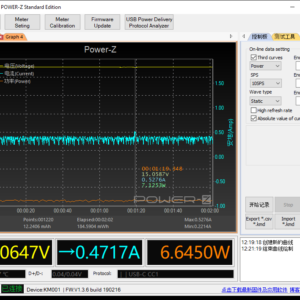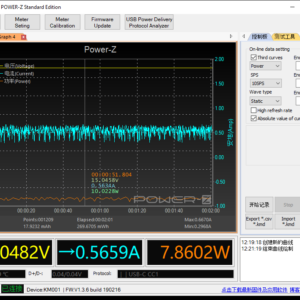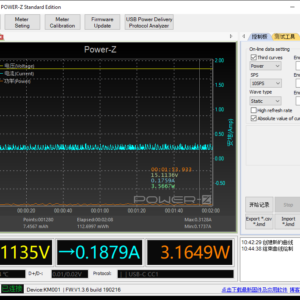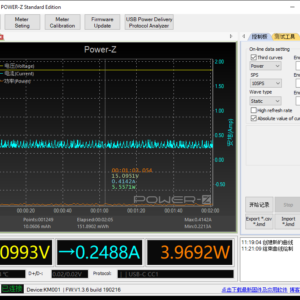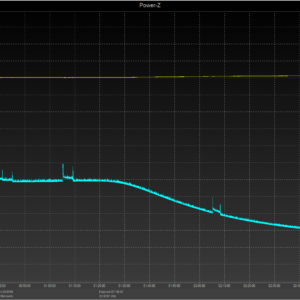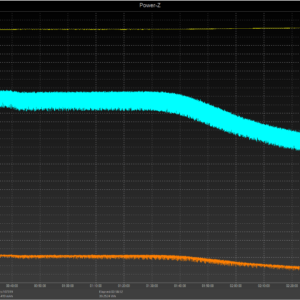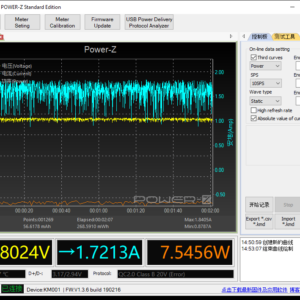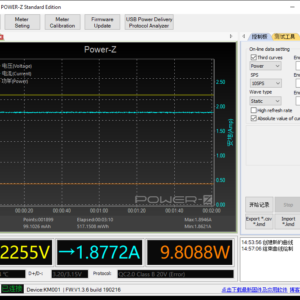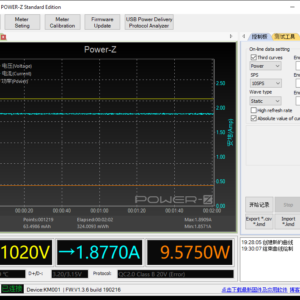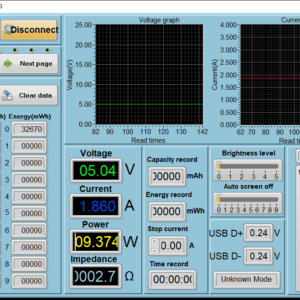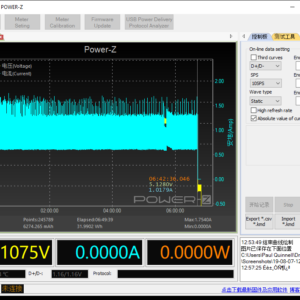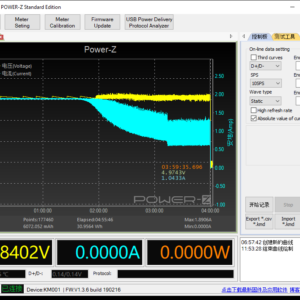In August 2019 Nintendo released an updated version of the Nintendo Switch. This revision featured a new system-on-chip (CPU and GPU combo), flash storage, and RAM. Those increased the power efficiency of the whole system. Here we’ll take a look at the resulting new playtimes, power usage, and charging of the console.
Play Time | Power Usage | Charge Time | Charging | Dock & AC Adapter | Summary
If you have questions on how the rest of the new Nintendo Switch compares with the original model check out Comparing the New and Old Nintendo Switch.
New Nintendo Switch Play Time
Nintendo listed the new Nintendo Switch as offering 2-2.5 more hours of playtime. It is the only change in specs they listed when comparing the new and original Switch.
Play Time Test Results
I tested a brand new HAC-001(-01) Nintendo Switch in handheld mode. Running Zelda: Breath of the Wild, one of the more power-hungry Nintendo games. The console and Joy-Cons were at 100% at the start. And time runs until the Switch turns itself off. The Switch stayed active by rigging the right analog stick to keep the camera panning around.
New & Original Nintendo Switch Play Times
| New Nintendo Switch, Stress Test | Original Nintendo Switch, Stress Test | New Nintendo Switch, Travel Test | Original Nintendo Switch, Travel Test | |
|---|---|---|---|---|
| Conditions: | Korok Forest Screen Brightness: 100% Auto Brightness: Off Wi-Fi & Bluetooth: On | Screen Brightness: 100% Auto Brightness: Off Wi-Fi & Bluetooth: On | Cliff at start of game Screen Brightness: 75% Auto Brightness: On Wi-Fi & Bluetooth: Off | Screen Brightness: 66% Auto Brightness: On Wi-Fi & Bluetooth: Off |
| Play Time: | 3:43 | 2:36 | 5:14 | 3:06 |
The original Switch numbers were pulled from this master list of Nintendo Switch game battery life. They line up with my own experience. And what others have reported over the past two years.
What Does This Mean?
Nintendo’s listed playtimes appear to be accurate. Under the most stressful conditions playtime came in a bit under their 4-hour minimum. But during normal play, you wouldn’t stress out the system as much. So getting an extra 17 minutes of playtime is quite reasonable.
With reduced settings, I got close to Nintendo’s 5.5 hours for Zelda: Breath of the Wild. Dropping screen brightness down to 50% would have gotten me to 5:30 without a problem.
New Nintendo Switch Power Usage
When Nintendo announced the hardware revision we saw it had the same size battery. But improved playtimes. That meant the new hardware must be more power-efficient. And indeed the research done into its new chipset came to the same conclusion. After testing the new console I can confirm there are significant power savings.
Power Usage Test Results
I measured how much power the new Nintendo Switch drew under various conditions. I tested a brand new HAC-001(-01) Nintendo Switch in handheld mode. A Power-Z KM001 power meter and software provided the measurements. The console and Joy-Cons were at 100%, so the power drawn was used to run the Switch.
New & Original Nintendo Switch Power Usage Results
| New Nintendo Switch, Stress Test | Original Nintendo Switch, Stress Test | New Nintendo Switch, Low Demand Test | Original Nintendo Switch, Low Demand Test | |
|---|---|---|---|---|
| Conditions: | Zelda: Breath of the Wild, Korok Forest Screen Brightness: 100% Auto Brightness: Off Wi-Fi & Bluetooth: On | Zelda: Breath of the Wild, Korok Forest Screen Brightness: 100% Auto Brightness: Off Wi-Fi & Bluetooth: On | Nintendo Entertainment System - Switch Online, Excitebike Screen Brightness: 100% Auto Brightness: On Wi-Fi & Bluetooth: On | Nintendo Entertainment System - Switch Online, Excitebike Screen Brightness: 100% Auto Brightness: On Wi-Fi & Bluetooth: On |
| Average Power Usage: | 6W | 8.25W | 3.25W | 4.75W |
| Max Power Usage: | 7.95W | 10W | 4.7W | 6.25W |
We can see improved power efficiency at work. My results show a 27-32% efficiency between the original and new model Switches. The results were consistent for both a high power draw and low power draw game. So we would expect to see similar results for any game under any condition.
The new Nintendo Switch can charge while playing with a wider range of chargers. If your power source provides less power than is being used the Switch’s battery will drain. Though at a slower rate than without any power source. If your power source provides more power than is being used the Switch’s battery will charge. The battery cannot both charge and discharge at the same time.
As with the original Switch, most USB-C chargers will provide enough power to charge and play. But with the new Switch, you can get away with using an older USB-A charger in most cases. Provided it offers enough power. And as we see below the new Nintendo Switch draws power at a different rate.
New & Original Nintendo Switch Power Usage Data
What Does This Mean?
The improved power efficiencies are real. They are observable. And they are significant. With the same size battery, it is obvious the new Switch would have increased playtime.
Additional Benefits of Reduced Power Usage
At one point during my testing process, I was running games on both the new and original Nintendo Switch. I needed to drain their batteries for the next test, so I was taxing both systems to speed up that process. The original Switch ramped up its fan and kept it on until I stopped the process. But the new Switch never generated any fan noise. And it had the more demanding Zelda stress test setup running.
Better power efficiency means less heat waste. Which gives several added benefits:
- Switch is cooler to the touch on average
- Internal fan doesn’t become audible as often
- Longer battery lifespan (heat is one of the killers of lithium batteries)
It would also allow Nintendo to enable more overclocking of the system. That said, I would not expect it to happen. Nintendo already introduced Boost Mode with update 8.0.0. Which loads compatible games faster by momentarily overclocking the system. With the reduced heat, it should be possible to overclock full time. With some hardware hacking, the original Switch can be overclocked. But the results include significant power usage and temperature increases. The new Switch would better handle those issues. But Nintendo tends to keep system performance conservative. In favor of a more reliable end-user experience under any condition.
New Nintendo Switch Charge Time
The new Nintendo Switch charges at close to the same rate as the original Switch when using the included AC adapter. There’s only a 15-minute difference between the two. Both Switch models charge faster than Nintendo claims while playing games.
Charge Time Test Results
I tested a brand new HAC-001(-01) Nintendo Switch in handheld mode. The console was at 0%, the power bank at 100%. For the sleeping test, the Switch was turned on after 5 minutes. Then put to sleep with no gaming running in the background. For the gaming test, the Switch was turned on after 5 minutes. Then launched Zelda: Breath of the Wild. The game ran under stress test conditions. With screen brightness at 100% and auto-brightness off. For both tests, Wi-Fi and Bluetooth were left on.
New & Original Nintendo Switch Charge Times
| New Nintendo Switch | Original Nintendo Switch | |
|---|---|---|
| Sleeping Charge Time: | 3:14 | 3:30 |
| Gaming Charge Time: | 2:58 | 3:15 |
The faster charge while playing is due to higher draw rates. When the Switch is asleep it maxes its power draw to 10-12W. Even with a low battery level. But while active it can get up to 18W with a low enough battery level. Under most power usage conditions you actually draw more power into the battery while playing. That said you should charge your Switch while it sleeps unless you are actually playing.
The new Switch has the same size battery as the original. And its max draw rate is the same when using the official Nintendo Switch AC Adapter. Or a third party 30-60W USB-C PD charger. What little decrease we see in charge time is likely due to the power efficiencies in the new model.
New & Original Nintendo Switch Charging Graphs
What Does This Mean?
In general, the new Nintendo Switch charges up at the same rate as the original model. If using the Switch’s original charger or a 30-60W USB-C PD charger you wouldn’t notice much of a difference.
If you use a third-party 18W USB-C PD charger then you will see a faster charge rate. Thanks to the improved power draw specs detailed below.
Charging the New Nintendo Switch
Besides playtimes and power usage, I also tested the power draw rates of the new Nintendo Switch. And was pleasantly surprised by the results. Nintendo has addressed issues where the Switch underdraws power at some voltages. Combined with the lower power usage this opens up a larger range of ideal charging options.
Charging the Original Nintendo Switch
It was discovered that the original Nintendo Switch drew power at different rates. It varied between USB-A, USB-C, and USB-C Power Delivery. And it didn’t always draw as much current (amps) as one might expect. Later I found that it also drew power at different rates under various USB-C PD power profiles. All this meant the Switch would charge faster with some chargers, and slower with others. Most USB-C chargers would provide enough power to charge and play. But with up to a 6W difference. And USB-A chargers may or may not keep up with gaming demands, depending on the conditions.
Original Nintendo Switch Power Draw Rates
These draw rates are unusual for a USB Power Delivery enabled device. Similar devices have a max draw rate in wattages and support certain voltages. For example, a Google Pixel supports up to 18W @ 5V or 9V. So it’ll draw up to 5V/3A (15W) or 9V/2A (18W). Expected under USB PD rules. The Switch supports up to 18W @ 5V, 9V, 12V, and 15V. But as you see the actual draw rates are not what we would expect based on specs. This made finding the optimal charger difficult.
New Nintendo Switch’s Power Draw Rates
The new Nintendo Switch has more typical draw rates for a USB Power Delivery device. It still has an ~18W max draw limit. But there is less of a power draw gap between different voltages. And it can draw more power from a USB-A charger than the original Switch.
I tested a brand new HAC-001(-01) Nintendo Switch in handheld mode. Its battery was at 20%. And it ran Zelda: Breath of the Wild under stress test conditions. This was all done to force the Switch to its max draw rate.
New Nintendo Switch Power Draw Rates
| Charger Specs | Power Drawn | Total Wattage | Percent of Current Drawn |
|---|---|---|---|
| 5V/1.5A USB-A | 5V/1.5A | 7.5W | 100% |
| 5V/2A USB-A | 5V/2A | 10W | 100% |
| 5V/2.4A USB-A | 5V/2A | 10W | 83% |
| 5V/3A USB-C | 5V/2A | 10W | 66% |
| 9V/2A USB-C PD | 9V/1.8A | 16.5W | 90% |
| 9V/3A USB-C PD | 9V/1.8A | 16.5W | 60% |
| 12V/1.5A USB-C PD | 12V/1.5A | 18W | 100% |
| 15V/1.2A USB-C PD | 15V/1.2A | 18W | 100% |
| 15V/2A USB-C PD | 15V/1.2A | 18W | 60% |
| 15V/3A USB-C PD | 15V/1.2A | 18W | 40% |
Chargers used:
- 5V/1.5A: Anker PowerCore 13400 Nintendo Switch Edition, USB-A port
- 5V/2A: Anker PowerCore 20100 Nintendo Switch Edition, USB-A port
- 5V/2.4A: Anker PowerCore 10000
- 5V/3A: AUKEY PB-Y14 20000 USB-C
- 9V/2A: Google 18W USB-C
- 9V/3A: Apple 61W USB-C Power Adapter
- 12V/1.5A: AUKEY PB-Y13 10000 USB-C
- 15V/1.2A: Anker PowerCore 10000 PD
- 15V/2A: Anker PowerCore 20100 Nintendo Switch Edition
- 15V/3A: ZMI PowerPlug Turbo
The new Switch has the power to draw improvements almost across the board. USB-A 5V/2A and better are equal to regular USB-C. And the gap between various USB-C PD power profiles is now only 1.5W. Where before it was up to 6W. The 9V chargers are now the “slowest” option. While 12V, the previous slowpoke, is now as good as 15V. The Switch is utilizing a higher percentage of the charger’s available current. Up to its own 18W draw limit.
New Nintendo Switch Power Draw Data
But Is It Safe To Use a Third Party Charger?
I saw no unusual behavior during any of my tests. And I used third party chargers for everything. As the Nintendo Switch AC Adapter is weird. And doesn’t always cooperate with my testing hardware.
It has always been safe to charge the Switch with a third-party charger or power bank. There have been no reports of quality chargers damaging a Switch. There have been problems with third party docks. But those issues stemmed from the poor build quality of the dock itself, not any charger. For more details check out Safely Charging the Nintendo Switch.
What Does This Mean?
A wider range of third-party chargers will perform well with the new Nintendo Switch. If you try a USB-A charger that provides 5V/2A or better you’ll have a good experience in handheld mode. But an iPhone’s 5V/1A charger will still provide a slow charge. If buying a new USB-C PD charger you don’t need to worry about its exact specs as much. The difference between any 18W charger is ~8%. Wherewith the original Switch it was up to 33%. For best results go for 18W USB-C PD chargers that offer 12V or 15V.
USB-A Charging Is Viable for the New Nintendo Switch, But Not Optimal
The improved power efficiencies and draw rates mean USB-A charging works better. It is viable under most conditions with the new Nintendo Switch. I had previously run tests using a USB-A power bank with the original Switch. Which found that plugging in while the Switch was at 100% worked best with a USB-A power source. I ran similar tests with the new Switch and compared the results.
In all tests, the Switch was connected to an Anker PowerCore 10000 power bank. Super Mario Odyssey was running. Screen brightness was at 100% with auto-brightness off. Wi-Fi and Bluetooth were on. And the Joy-Cons were fully charged.
New & Original Nintendo Switch USB-A Power Bank Charging
| New Nintendo Switch @ 100% | Original Nintendo Switch @ 100% | New Nintendo Switch @ 50% | Original Nintendo Switch @ 50% | |
|---|---|---|---|---|
| Power Bank's Run Time: | 6:42 | 4:25 | 3:59 | 4:15 |
| Switch's Final Battery Level: | 100% | 98% | 100% | 39% |
| Total Expected Play Time: | 10:42 | 7:00 | 8:00 | 5:15 |
The original Switch needed to plug in at 100%. Otherwise, the demands on both the game and a reduced battery were too much. And the Switch’s battery would continue to drain. While the drain was at a reduced rate it affected the total playtime of both the Switch’s battery and power bank.
The new Switch was able to play and charge under both conditions. Thanks to lower power usage. And an increased power draw from 5V/2.4 USB-A chargers. But plugging in at 100% is still ideal, as it gave the most possible playtime.
Not every USB-A charger will give similar results:
- 5V/2A – 5V/2.4A: Will charge and play under all conditions
- 5V/1.5A: Will charge and play under most conditions
- 5V/1A: Will charge and play under some conditions
New Nintendo Switch USB-A Power Bank Data
So Should I Buy a USB-A Charger Instead of USB-C PD?
I maintain my general advice to buy a USB-C Power Delivery charger over USB-A.
If you already own a USB-A power bank, then by all means give it a go. If it meets your needs, great.
But if you need to buy a new power bank for your Nintendo Switch, original or new, a USB-C PD is a better value.
- USB-C PD charges the Switch faster, and charges while you play under any condition
- Fast charges other USB PD devices, including newer iPhones, Samsung Galaxy, and Google Pixel
- The same USB-C PD charger could handle your phone, Switch, and laptop
- Future proofs you against new USB-C devices
- USB-C charger can include the proper USB-C cable, a USB-A charger requires a separate cable
A USB-A power bank is generally cheaper than a USB-C PD power bank of the same capacity. But keep included cables in mind, as the total cost difference maybe $10 or less.
Dock & AC Adapter
Both the dock (HAC-007) and the AC adapter (HAC-002(USZ)) included with the new Nintendo Switch have not changed. They have the same model numbers and tech specs as what came with any day one Switch.
No New Dock
I was able to connect the new Switch to my original dock. And vice versa.
The dock still has a 15V/2.6A (or more amps) power input requirement. Aside from the Nintendo Switch AC Adapter, most 45-60W USB-C PD chargers will power the dock. But chargers with less output will not.
And the dock still has a much smaller power draw than its input requirement lets on. It draws ~18W with the Switch connected and charging. Most of that going to the console. With some for the dock’s video converter and USB ports. The 39W requirement has long been thought to be Nintendo’s way of making sure their own charger was being used.
And No New AC Adapter
The Nintendo Switch AC Adapter has the same 5V/1.5, 15V/2.6A power profiles listed as its specs. And confirmed by my PD sniffer. Like the AC adapter to any model Switch, it works well with the dock, console, and even Pro Controller. But the limited power profiles keep it from being a good charger for many other USB-C devices. Including phones, 18W power banks, and some laptops.
Summary
The new Nintendo Switch lives up to its promised playtimes. It fell a bit short under my stress test. But it met Nintendo’s advertised times under more normal gaming conditions. Their 5.5 hours of Zelda playtime is doable with screen brightness ~50% and airplane mode turned on.
The increased playtime comes from improved power usage efficiency. My data showed 27-32% lower power usage compared to the original Switch. With the same size battery that gives us 39-80% longer playtimes. And less heat, which kept the new Switch cooler and quieter.
Charge times for the new Switch were close to the original. The 15 minutes improvement could be from improved power usage efficiency. Or other variables in comparison testing.
Nintendo quietly improved the power draw rates of the new Nintendo Switch. It still has an ~18W max power draw. But it gets much closer to that max with 18W USB-C PD chargers. And 10-12W USB-A chargers also saw an improvement. Combined with lower power usage many USB-A power banks are now viable. Though the best chargers to buy are still USB-C PD.
There are no changes to the dock or included power adapter. You can mix and match them with an original Switch. They provide the same functions. And have the same limitations.
For comparison beyond just power check out Comparing the New and Old Nintendo Switch.
Where Can You Find the New Nintendo Switch?
The new Nintendo Switch is available on Amazon.
Best Buy is also offering it with free shipping or store pick up.
Many GameStop stores have it in inventory. But it isn’t available on their website yet.
Target, Walmart, and other retailers are putting out the new model as the older model sells. Look for the telltale red box in their display cases.







